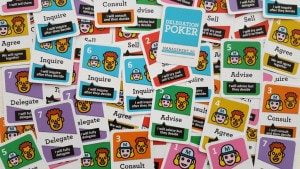High Performance Defined
From Wikipedia: A high-performance team (HPT) can be defined as a group of people with specific roles and complementary talents and skills, aligned with and committed to a common purpose, who consistently show high levels of collaboration and innovation, that produce superior results.
Characteristics of an HPT
- Participative leadership
- Effective decision-making
- Open and clear communication
- Clear goals, values, and principles
- Valued diversity
- Mutual trust
- Managed conflict
- Defined roles and responsibilities
- Coordinative relationship
- Positive atmosphere
- Continuous Improvement
Participative Leadership and Effective Decision Making

Decision-making is a great deal more than “Either you do it or I do it.” In Managing for Happiness, Jurgen Appelo provides a delegation matrix with seven levels of decision making.
I am experimenting with a matrix that provides four types of decisions/actions for high-performance Agile teams (of any size):
- Ones that only leaders can make/take (Type 1 can be made with or without consultation/discussion/buy-in with/from the team, consultation is of course preferred. Jurgen breaks this type down into a total of three separate levels.)
- Ones that individuals/teams can and should make/take themselves, but need to first check-in with stakeholder/leaders (consult, discuss, inquire); and in the event of a “tie” or a disagreement on how to proceed, the individual/team calls it. (If the individual/team is not willing to take accountability, then call it a Type 1; sorry, there is no “1.5”)
- Ones that individuals/teams can make/take themselves, and inform others (stakeholders, leaders, managers, other teams) after the fact (either “contemporaneously” or “routinely”)
- Ones that individuals and teams can make/take themselves. “Just do it.”
Ok, technically there’s a fifth type in my matrix:
- Wait until you are told what to do by the leader.
We don’t want those. Why? For a boatload of reasons: No one person can know as much as a talented team; decision making in one spot becomes a bottleneck; being told what to do demotivates a team and removes accountability.
Here’s a possible response to a type 5 “directive”
- You are asking me to ________
- I think the outcome you are looking for is ________
- We can do ________
- To meet the same outcome but with better [quality, compliance, speed…] because ________
- How do you feel about the different approach?
Where does control live?
Newly formed teams typically start off heavily skewed with lots of Type 1’s, and few and fewer of the other types as you go down the list.
And as a team matures and becomes more gelled and more performant (Retrospectives help on this path), the balance reverses. More Type 4’s, 3’s, and 2’s and very few 1’s.
Why? Because by pushing decision making control and accountability down down down deep into the team we reduce bottlenecks, we reduce wait times, we reduce waste, and we multiple by orders of magnitude the speed at which our teams can move.
Getting There…
In David Marquet’s book “Turn the Ship Around” we can observe the development and maturation of an effective Agile team (in the environment of the nuclear submarine of all places) moving away from nothing but type 1 decisions (traditional command and control pattern) to a model that is incredibly more effective and responsive.
Observe the evolution of the leader’s (Submarine Captain’s) and his teams’ speech patterns:
From traditional leader-follower behavior:
- Captain: “Submerge the ship”
- Subordinate: “Submerge the ship, aye”
…To pushing control down in the organization:
- Captain: “What do you think we should do?”
- Subordinate: “I think we should submerge the ship, sir”
- Captain: “Then tell me you intend to do that”
- Subordinate: “Captain, I intend to submerge the ship”
- Captain: “Very well”
…Then evolving the pattern to include an assurance of technical competence:
- Subordinate: “Captain, I intend to submerge the ship.”
- Captain: “What do you think I’m concerned about?”
- Subordinate: “You’re probably concerned about whether it’s safe to do so”
- Captain: “Then convince me it’s safe”
- Subordinate: “Captain, I intend to submerge the ship. All crew members are below decks, the hatches are shut, the ship is rigged for dive, and we’ve checked the bottom depth.”
- Captain: “Very Well”
…To the next evolution of language adding clarity of mission:
- Subordinate: “Captain, I intend to submerge the ship. All crew are below decks, the hatches are shut, the ship is rigged for dive, and we’ve checked the bottom depth.”
- Captain: “Is it the right thing to do?”
- Subordinate: “Yes sir, our mission requires that we submerge now in order to (classified reason (-: ) ”
- Captain: “Very Well”
Not mentioned in the book, and I have no way of knowing if the final evolution of this behavior onboard a sub should sound like this, but wouldn’t the following Leader to Leader communication pattern and the corresponding accountability be pretty cool:
- Subordinate: “Captain, our mission requires that we submerge in order to (classified reason (-: ). Accordingly, I am submerging the ship. All crew are below decks, the hatches are shut, the ship is rigged for dive, and the bottom depth is sufficient.”
- Or even more simply: “Captain, submerging the ship.”
Leadership guru Stephen Covey took a tour of Marquet’s submarine when the crew had reached a “mature” stage and reported that it was the most empowered organization he’d ever experienced, of any type.
The Power of Words
As the examples above show, a key indicator of where a team is in the spectrum of performance/maturity/accountability rests in the language the team members use. Here is a shortlist of “disempowered phrases” that you will not hear from members of a HPT:
- Request permission to . . .
- I would like to . . .
- What should I do about . . .
- Do you think we should . . .
- Could we . . .
Contrast these with a shortlist of phrases that you’ll hear all the time when a team is at or near a local peak of performance (yes, “a local peak”… the journey never ends):
- I intend to . . .
- I plan on . . .
- I will . . .
- We will . . .
- I did / We did . . .
Open and clear communication, right? See also: Say Mean Do
Start the Journey
Where is your team today? Where do you want to go? How will you get there?
One of the most important things you as a leader can do to help your team is to simply stop giving in to “having all the answers.”
When you hear the question: “What should I do about . . .” try simply answering with: “What would you do if you were me?”
More on this approach here: Stop giving answers…
What Happens Inside the Team’s Boundaries
For decisions that the team makes (Type 2, 3, and 4) – there are many patterns to consider. None of them perfect, there are strengths and weaknesses to each. Check out the options here: Decision-Making Patterns for Teams
Read More
Here are some additional resources that may help along the path you’re on:
- How Can Groups Make Good Decisions
- #Workout: How Delegation & Authorization Foster Employee Engagement
- Delegation Poker How do you decide Who does What?
- Management 3.0 – Empower Teams
- How to play Delegation Poker
- How Asana Gives Decision-Making Power to Every Team Member
- A classic HBR article from the way back machine. “Who’s Got the Monkey?” Look thru the old school management lecture to get to the kernel – are you “accepting the monkey” and holding your team back?
- Intent Based Leadership – David Marquet’s website with a his first book “Turn the Ship Around”, a follow up workshop handbook “Turn Your Ship Around”, and the home of the Weekly Nudge.
- Wilford Bion – Experiences in Groups – “A classic study which, by synthesizing the approaches of psychoanalysis and group dynamics, has added a new dimension to the understanding of group phenomena.”
- Why Motivating Others Starts with Using the Right Language, post by David Marquet
- Tuckman’s Stages of Group Development
- The New Science of Building Great Teams
- Delegation Map

